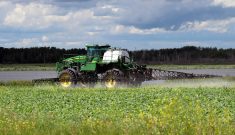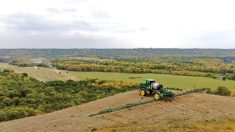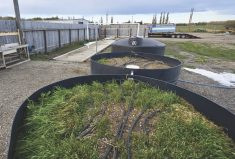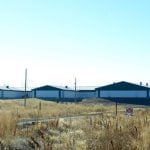Keeping a clean farmyard is an easy sell for most producers. Even if it’s something individual farmers may struggle with, it’s still a goal for most growers wishing to be good neighbours and set an example for their industry.
However, keeping a clean farm doesn’t stop at the farm gate. In recent years, recycling end-of-life inorganic farm waste has, in many cases, become as easy as taking those same products to the local landfill.
Cleanfarms, a non-profit, ag-driven, environmental stewardship organization, has been behind much of that progress. Cleanfarms has set up more than 1,400 collection points across the country aimed at ag plastic recycling and — in the case of unused pesticides — safe disposal.
Read Also

Cancer agency reclassifies another herbicide ‘probably carcinogenic’
The WHO’s cancer research agency has now put atrazine, a herbicide well known to corn growers, in the same potential-hazard category where the agency put glyphosate.
And although there’s always room for improvement, for the most part, it’s working. “We’re creeping up to 80 per cent of all (fertilizer and pesticide) small containers coming back through our program,” says Barry Friesen, executive director of Cleanfarms.
“Today, Cleanfarms has more than 70 members that are in the crop protection, fertilizer, seed, animal health medication and grain bag industries. There is a strong commitment to sustainability throughout the membership.”
Basically, wherever you farm in Canada, there’s a good chance there’s a collection point close to you or a program that can meet your needs, says Friesen. Below is a rundown on Cleanfarms’ full suite of ag waste management programs for farmers.
Container programs
Container programs are available with no drop-off fee. One is a coast-to-coast program dedicated to collecting empty pesticide and fertilizer containers (23 litres and smaller) for recycling. The other collects large, plastic or metal pesticide containers and, depending on the manufacturer, fertilizer totes and barrels from 23 to 1,000 litres in every province.
Producers can find their local collection points by visiting the Cleanfarms website and following the links. Depending on the province, these locations can either be the retail outlet from which the products were originally purchased or a municipal location of some kind. These outlets offer collection bags of various sizes free of charge, says Friesen.
“We have started to supply all of the (participating) retailers with bags they can give to farmers that they can put their containers in and still bring them back to the municipal locations. In the past, the containers went back loose.”
Unwanted pesticides
Sometimes farmers have half-empty containers of old or obsolete pesticides that need to be dealt with. Cleanfarms has a free program that collects these pesticides on a rotating basis, meaning every region is covered once every three years. For those with horses or livestock, the same program also collects livestock and equine medication.
“We don’t recycle leftover chemicals and animal health products. We safely dispose of them on behalf of the farmer,” says Friesen.
Seed, pesticide, inoculant and grain bags
Cleanfarms has a series of collection programs for bags formerly containing farm products. Empty seed and pesticide bags are collected for responsible disposal in Eastern Canada, with empty fertilizer bags collected in Quebec on a regional and pilot basis.
There’s currently a pilot program for empty, used seed, pesticide and inoculant bags in Manitoba, Saskatchewan and south-central Alberta. “We’re rolling it out across the Prairies in pilot form right now as we speak, and we hope it’ll be permanent by 2023,” says Friesen.
Grain bags are collected by Cleanfarms partners for recycling under extended producer responsibility policies in Saskatchewan and Manitoba as well as pilots in Alberta and the Peace River region of northern British Columbia.
“Extended producer responsibility” essentially means the collection of these materials is enforced by regulation and there may be a cost to the farmer, often in the form of an environmental handling fee attached when the grain bag is originally purchased. Friesen compares such policies to “eco-fees” tied to consumer electronics products.
“That’s the same thing that happens with the grain bag program in Saskatchewan and Manitoba. When you buy a new grain bag, you pay a fee. That goes into a small fund we use to help pay for the collection and recycling of the materials.”
Regulations around grain bag collection and recycling can differ from province to province. Cleanfarms’ website has details about these regulations and their enforcement bodies.
Plastic baler twine
Plastic baler twine is collected for recycling in Manitoba under an extended producer responsibility policy.
In British Columbia, Saskatchewan, Ontario, Quebec and Prince Edward Island, twine is collected through pilot programs funded in part by Agriculture and Agri-Food Canada’s Canadian Agricultural Strategic Priorities Program (CASPP). In Alberta, Cleanfarms collects baler twine in a three-year pilot led by the Agricultural Plastics Recycling Group with funds granted by the Government of Alberta and administered by Alberta Beef Producers.
How to find collection points
Producers can find their closest recycling collection points at www.cleanfarms.ca. Although most of these sites are a reasonable distance from producers, there may be instances where growers are a long way from their nearest collection facility.
Cleanfarms is working on filling in any gaps in service. “Cleanfarms is continually assessing our collection network and analyzing how to make it more convenient for growers to access collection sites and to increase awareness of the options that are available,” says Friesen.
















